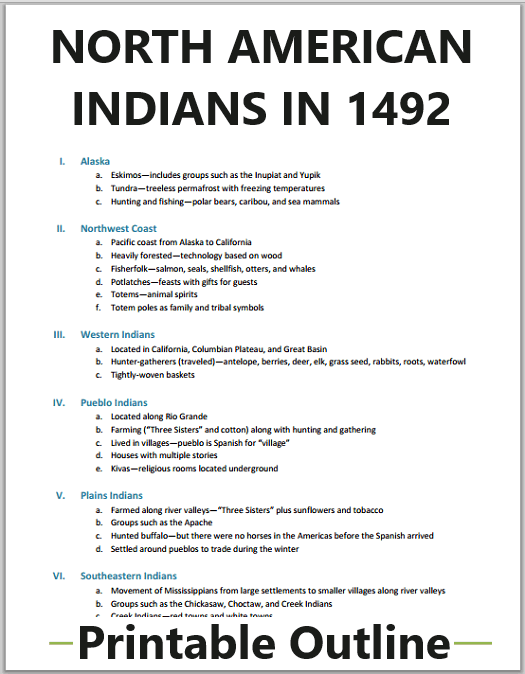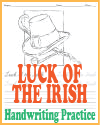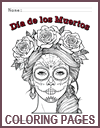| Native North American Indians in 1492 Outline |
|---|
| www.studenthandouts.com ↣ U.S. History ↣ Early America ↣ Early America Outlines & PPTs |
 |
    |
|
Click here to print. Click here for a PowerPoint version of this outline. I. Alaska a. Eskimos—includes groups such as the Inupiat and Yupik b. Tundra—treeless permafrost with freezing temperatures ; dc. Hunting and fishing—polar bears, caribou, and sea mammals II. Northwest Coast a. Pacific coast from Alaska to California b. Heavily forested—technology based on wood c. Fisherfolk—salmon, seals, shellfish, otters, and whales d. Potlatches—feasts with gifts for guests e. Totems—animal spirits f. Totem poles as family and tribal symbols III. Western Indians a. Located in California, Columbian Plateau, and Great Basin b. Hunter-gatherers (traveled)—antelope, berries, deer, elk, grass seed, rabbits, roots, waterfowl c. Tightly-woven baskets IV. Pueblo Indians a. Located along Rio Grande b. Farming ("Three Sisters" and cotton) along with hunting and gathering c. Lived in villages—pueblo is Spanish for "village" d. Houses with multiple stories e. Kivas—religious rooms located underground V. Plains Indians a. Farmed along river valleys—"Three Sisters" plus sunflowers and tobacco b. Groups such as the Apache c. Hunted buffalo—but there were no horses in the Americas before the Spanish arrived d. Settled around pueblos to trade during the winter VI. Southeastern Indians a. Movement of Mississippians from large settlements to smaller villages along river valleys b. Groups such as the Chickasaw, Choctaw, and Creek Indians c. Creek Indians—red towns and white towns d. War leaders drawn from red towns e. Main chiefs drawn from white towns f. Hunted animals like deer in the winter g. Green Corn Dance—played two-stick lacrosse VII. Northeast Indians a. Groups such as Algonquin and Iroquois b. Algonquins lived in wigwams (round, covered in bark) c. Iroquois lived in longhouses (about 10 families in each) d. Mixture of farming and hunting e. Slash-and-burn agriculture VIII. League of the Iroquois a. Cayuga, Mohawk, Oneida, Onondaga, and Seneca b. Great Law of Peace created by prophet known as the Peacemaker and promoted by Hiawatha c. Grand Council, consisting of chiefs from each tribe, operated under fairly democratic constitution d. Protected rights of women and children IX. Review Questions a. What was life like for groups such as the Inupiat and Yupik in Alaska? b. What were potlatches? c. What is a pueblo? d. What large animal was hunted by Plains Indians? e. Where and when was two-stick lacrosse played? f. Describe the homes of the Algonquin and the Iroquois. g. What was the League of the Iroquois and what did it do? h. How might you generally describe the groups of Native Americans living in North America in 1492? |
| Early America Books and Films | Early America Image Galleries |
| Early America Learning and Study Games | Early America Miscellany |
| Early America Outlines and PowerPoints | Early America Worksheets |
| www.studenthandouts.com ↣ U.S. History ↣ Early America ↣ Early America Outlines & PPTs |








